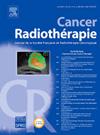原发性脑肿瘤放疗后永久性脱发:影响最大的因素
IF 1.4
4区 医学
Q4 ONCOLOGY
引用次数: 0
摘要
目的:脱发是原发性脑肿瘤患者接受放疗时出现的一种令人痛苦的副作用。本研究旨在调查与接受调强放射治疗的脑肿瘤患者永久性头皮脱发相关的最有影响力的临床、人口统计学和剂量学因素:共招募了80名接受调强放射治疗的脑肿瘤患者。纳入标准为患有原发性脑肿瘤且接受过至少 18 个月的放疗。头皮脱发采用不良事件通用术语标准(CTCAE)v5.0进行评估。在随访的磁共振成像上标记和划定脱发的头皮位置,并记录计划剂量参数,包括D0.1cm3(最大剂量)、平均剂量和各种体积参数,如V16Gy-43Gy(间隔约5Gy)。此外,还采用了接收器操作特征(ROC)曲线分析来确定慢性脱发的预测参数:结果:70%的病例脱发严重程度为一级,30%为二级。男性性别、化疗史和脱发家族史与脱发毛囊数量增加有显著相关性。相关性和 ROC 分析表明,接受 30Gy 或更高剂量(即 V30Gy)治疗的区域出现 2 级脱发的风险较高。由此得出的曲线下面积为 0.694,表明所考虑的剂量-体积直方图参数与患者永久性脱发之间存在中度相关性。尽管这些结果在统计学上并不显著,但这些研究结果表明,特定的剂量学参数,如 V30Gy 至 V43Gy,可能是预测 2 级慢性放射诱导性脱发的最有力指标。V30Gy至V43Gy的临界值也分别约为13.5至8立方厘米,这可以作为脑部调强放疗后剂量-体积直方图阈值的指标,超过该阈值将出现永久性脱发:结论:调强放疗后永久性脱发的发生率受人口统计学、剂量学和临床因素(如性别、化疗史和家族史)以及接受30Gy或更高剂量的颅骨滤泡区的影响。本文章由计算机程序翻译,如有差异,请以英文原文为准。
Permanent alopecia after radiotherapy of primary brain tumours: The most influential factors
Purpose
Alopecia is a distressing side effect of radiotherapy in patients undergoing treatment for primary brain tumours. This study aimed to investigate the most influential clinical, demographic, and dosimetric factors associated with permanent scalp alopecia in patients with brain tumours treated with intensity-modulated radiations.
Patients and methods
Eighty patients with brain tumors treated with intensity-modulated radiations were enrolled. Inclusion criteria were having a primary brain tumour and patients with at least 18 months of radiotherapy. Scalp alopecia was evaluated using the Common Terminology Criteria for Adverse Events (CTCAE) v5.0. The scalp location with hair loss was marked and delineated on their follow-up MRI, and the planning dosimetric parameters, including D0.1cm3 (as maximum dose), mean dose, and various volumetric parameters such as V16Gy-43Gy (with about 5 Gy interval) were recorded. In addition, receiver operating characteristic (ROC) curve analysis was employed to identify predictive parameters for chronic alopecia.
Results
The hair loss severity was grade 1 for 70 % of cases, and grade 2 for 30 %. Male gender, history of chemotherapy, and family history of hair loss were significantly associated with increased volume of hair loss follicles. The correlation and ROC analysis revealed that regions receiving doses of 30 Gy or higher (i.e., V30Gy) were associated with a higher risk of developing grade 2 alopecia. The resulting areas under the curve of 0.694 were indicators for moderate correlations between the considered dose–volume histogram parameters and patients’ permanent alopecia. Even if these results were not statistically significant, these findings suggest that specific dosimetric parameters, such as V30Gy to V43Gy, maybe the strongest predictors of grade 2 chronic radiation-induced alopecia. The cut-off values were also about 13.5 to 8 cm3 for V30Gy to V43Gy, respectively, which can be played as an indicator of the dose–volume histogram threshold above which permanent alopecia will be expected after brain intensity-modulated radiotherapy.
Conclusion
The incidence of permanent alopecia after intensity-modulated radiotherapy is influenced by demographic, dosimetric, and clinical factors such as gender, history of chemotherapy, and family history, and the skull follicle regions receiving doses of 30 Gy or higher.
求助全文
通过发布文献求助,成功后即可免费获取论文全文。
去求助
来源期刊

Cancer Radiotherapie
医学-核医学
CiteScore
2.20
自引率
23.10%
发文量
129
审稿时长
63 days
期刊介绍:
Cancer/radiothérapie se veut d''abord et avant tout un organe francophone de publication des travaux de recherche en radiothérapie. La revue a pour objectif de diffuser les informations majeures sur les travaux de recherche en cancérologie et tout ce qui touche de près ou de loin au traitement du cancer par les radiations : technologie, radiophysique, radiobiologie et radiothérapie clinique.
 求助内容:
求助内容: 应助结果提醒方式:
应助结果提醒方式:


